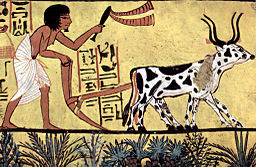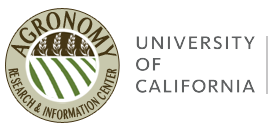In 1904, a Division of Experimental Agronomy was established in the College of Agriculture of the University of California, Berkeley. From the beginning, the division's major emphasis was on cereal crops. By 1906, it was clear that a Berkeley location for experimental work could not meet requirements of the agriculture that was developing in the Central Valley, and the division was largely shifted to the University Farm at Davis. The two-year non-degree program included practical work in agronomy, while experiment station research focused on developing improved cereal and range crop varieties.

In the early years of the division, the faculty was largely organized by crop or commodity basis, each member having a specialization such as plant breeding, crop physiology, or soil fertility. There were active programs on wheat, barley, rye grass, white and berseem clovers, all classes of dry beans, safflower and other oil crops, cotton, sugar beets, range improvement, seed certification, and foundation seed. Plant breeding was a major part of the department's research, with an active program in cereals, forage and food legumes, and oil crops.The division of agronomy, like the entire teaching program at Davis, was rebuilt after World War II and the faculty in the renamed Department of Agronomy grew rapidly in number, forming a young, energetic group similar in age.

In 1968, the name of the department was changed to Agronomy and Range Science to reflect the inclusion of a program devoted to the management of range lands, which constitute a significant portion of the state. Over the years, departmental faculty and staff became active in other areas as well, including Integrated Pest Management and the Plant Growth Laboratory. Members of the department played a significant role in the development of cross-departmental programs such as the Genetic Resources Conservation Program, the Sustainable Agriculture Research and Education Program, the Sustainable Agriculture Farming Systems Project, the Long-Term Research in Agricultural Systems 100-year experiment, the East Asia Center on Population Resources and Welfare, and the Global Livestock Collaborative Research Project.
Throughout subsequent years, the department was organized along four major broad disciplinary lines: genetics, breeding, and genomics; quantitative agronomy (applications of information technology to agriculture); crop physiology and ecology; and range and natural resource management. The department's ongoing challenge was to span the full spectrum of research from the basic to the applied levels. Outreach continued to be an essential component of department activities, with UCCE statewide specialists and farm advisors assuring the relevance of research programs. In 2004, the department was consolidated with three other departments (Environmental Horticulture, Pomology, and Vegetables Crops) to form the new broadly-defined Department of Plant Sciences.
- The above information (with some revisions) written by Dr. Paul Gepts and obtained from Abundant Harvest: The History of the University of California, Davis by Ann F. Scheuring.
